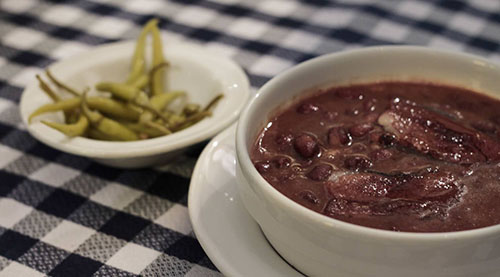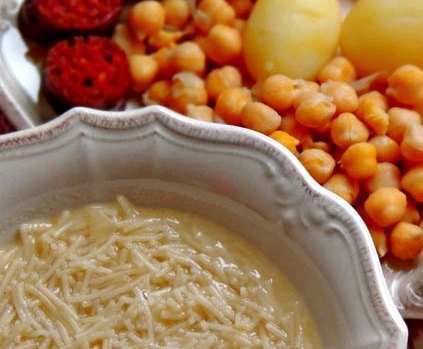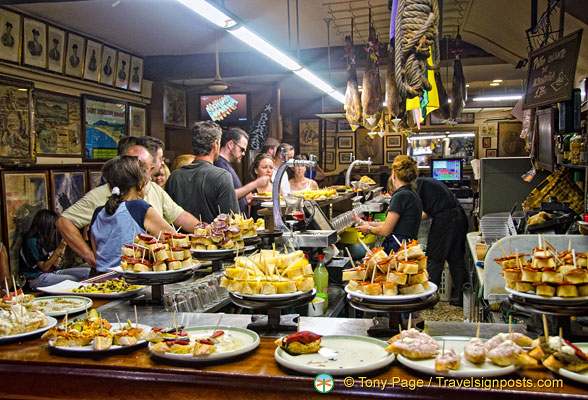Alubias Rojas de Tolosa
Tolosa's Red Bean Stew
Tolosa, located about twenty miles south of San Sebastián, in the Basque Country, becomes lively on Saturdays, the town’s market day. People from all over the area flock there for the exceptional local produce. The dried red beans of the region are particularly flavorful and thus highly prized. If you should visit Tolosa one day, seek out one of the numerous bars or restaurants there that serves this red bean stew, which is traditionally accompanied with the spicy-hot pickled peppers known as guindillas. My favorite place to eat it is Herriko Etxea, a tavern in Albiztu, only minutes away by car from Tolosa.
These famed dried red beans, as well as dried white ones, are called alubias in the Basque Country and in neighboring areas in northern Spain. In the rest of the country, however, dried beans are usually called judías, literally, “Jewish.” I find it surprising that lubia, Arabic for “bean” (al is the article), is used in precisely those parts of Spain where the Moors had relatively little influence— a curiosity for which I have no explanation.
- Serves 8 as a first course
Ingredients
- 1 ½ pounds dried Alubias Rojas Tolosarras (or red kidney beans)
- 6 tablespoons olive oil
- ½ yellow onion, finely chopped
- 5 ounces salt pork, in one piece
- 3 (3-ounce) chorizos
- 6 cups water
- Salt
- 1 small head green cabbage, coarsely chopped
- 3 (3-ounce) morcillas
- 1 clove garlic, thinly sliced
- 8 pickled guindilla chiles
Preparation
Rinse the beans in a colander under cold running water. Place in a bowl, add water to cover by 2 inches, and let soak for at least 8 hours or up to overnight.
Drain the beans, place in a stockpot, and add water to cover by 1 inch. Add 2 tablespoons of the olive oil, the onion, and the salt pork and bring to a boil over high heat. Decrease the heat to medium-low and cook, uncovered, at a gentle boil, stirring occasionally.
After the beans have cooked for 1 hour, add the chorizos. Add warm water if needed to keep the beans covered, and continue to boil gently for 1 hour longer, or until the beans are tender.
Meanwhile, in a saucepan, bring the 6 cups water to a boil over high heat. Salt the water lightly, add the cabbage, and cook for about 20 minutes, or until the cabbage has lost its volume. Decrease the heat to medium, add the morcillas, and cook for 20 minutes longer, or until the morcillas are fork-tender. Lift the sausages from the pot and keep them warm on a serving platter. Drain the cabbage, squeezing it thoroughly to eliminate any excess liquid. In a sauté pan, heat the remaining 4 tablespoons olive oil over medium heat. Add the garlic and sauté for 2 to 3 minutes, or until golden. Add the cabbage and turn several times in the oil and garlic to heat through and blend the flavors. Transfer the cabbage to a serving platter and keep warm.
When the beans are tender, remove the chorizos and salt pork to the platter holding the morcillas. Slice the sausages and salt pork into 2-inch pieces. (For ease, you can transfer the meats to a cutting board for slicing and then return them to the platter.)
Transfer the beans to a warmed serving bowl and place on the table along with the platter of sausages and salt pork and the platter of cabbage. Offer the guindillas on the side.
You may be also interested in...
See also
Platos de cuchara: Scores of soups and legume stews, called platos de cuchara, literally “dishes eaten with a spoon,” are beloved across the country. Many of them are regional variations of national favourites, and in this section, we have included recipes that reflect that diversity.
Basque Recipes: Basques live for cooking and eating. I haven't found a similar level of passion anywhere I have traveled. If we try to describe Basque cuisine, a fair answer might be that it is deeply felt, honors tradition, and respects the natural flavors of the ingredients. These qualities are on display in the significant number of dishes that are distinctively Basque.








